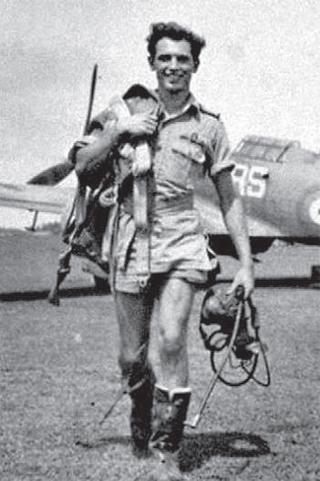31 Jan 2023 - {{hitsCtrl.values.hits}}
 By this time, an additional factor had emerged - the Ceylon Government was facing opposition from nationalist and Marxist forces due to burgeoning economic problems. It was difficult to give any significant concessions to the British military By this time, an additional factor had emerged - the Ceylon Government was facing opposition from nationalist and Marxist forces due to burgeoning economic problems. It was difficult to give any significant concessions to the British military |
 |
 |
 |
| A British fighter pilot returns from a sortie in Ceylon during World War II
|
The UK-Ceylon Defence Pact of 1947 was entered into with great expectations from both parties. But it was jinxed from the word go. Continually contested right throughout its existence, it was given a quiet burial by mutual consent in 1957.
The story of the hard-nosed negotiations and the final derogation of the Agreement by the SWRD Bandaranaike government in 1957 is told in detail by Robert Barnes of York St. John University, UK, in his 2022 publication entitled: In the Mutual Interest’: The Making and Breaking of the United Kingdom-Ceylon Defence Agreement, 1947–1957 (Taylor and Francis).
Following the end of World War II, UK decided to grant independence to Ceylon as part of the de-colonizing process. But there was a condition attached to it, namely, independent Ceylon should allow the UK to retain its naval and air bases at Trincomalee and Katunayake respectively through a UK-Ceylon Defence Agreement.
The UK needed the bases to meet the emerging threat to its still vast empire from the USSR and also Communist China which was then looming in the horizon. As for Ceylon, it needed a British military presence to meet a perceived threat of an ‘invasion’ from an independent India that was keen to play a dominant role in Asia.
However, despite the shared strategic interest in the defence of the island there were serious differences over the terms and conditions of the proposed Defence Agreement. The issues were: who would bear the cost of maintaining and staffing the bases; where will the money come from; under whose control will the bases be; and for how long would the arrangement last.
The UK and Ceylon both pleaded inability to bear the cost singly. Ceylon was poor and the UK had been devastated by the war. While Ceylon wanted to have overall control over the bases and the use to which they would be put, the UK wanted the bases to serve its geopolitical interests in South East Asia as a whole, an objective that Ceylon did not share. Ceylon looked at the British military presence principally as a shield against a perceived ‘Indian invasion’, but the British ridiculed such an expectation and wanted the bases for resisting Soviet (and later Communist Chinese) inroads into Asia. Thus,their geopolitical interests clashed.
However, because the dispute threatened to delay Ceylon’s independence, both sides felt a need to wrap-up the pact by making the terms and conditions “vague” leaving the blanks to be filled later. It was also decided to state that the bases will be held by the British “in the mutual interest” of the two parties, thus assuring Ceylon that if it did not see a “mutual interest”, it could terminate the agreement. The Defence Agreement was signed in 1947 and Ceylon received independence in 1948.
In the years that followed the geopolitical situation across the world became worse for the British. Communist China had emerged in 1949 and the Korean war had begun in 1950. In this context UK began to press for filling in the blanks in the 1947 Agreement as per its interests. Initially, Ceylon was agreeable because the Soviets had irked it by vetoing its entry into the UN on the grounds that with British bases in it, Ceylon was not an ‘independent’ country.
But during the talks, issues of funding and control surfaced up again. By this time, an additional factor had emerged - the Ceylon Government was facing opposition from nationalist and Marxist forces due to burgeoning economic problems. It was difficult to give any significant concessions to the British military.
D.S. Senanayake’s proposal
In the first instance, Prime Minister D.S. Senanayake proposed that Ceylon purchase the lands on which the bases were built and then lease them out to Britain. Britain agreed on the condition that it would be able to keep the bases as long as it required. However, the then Foreign Secretary, Sir Kanthiah Vaithianathan, told the British that the Ceylonese people would not allow precious land to be alienated to meet the needs of the British military. But Senanayake was more amenable because due to the denial of citizenship to the people of Indian origin, he feared an Indian military intervention.
However, given the parlous state of Ceylon’s economy, Senanayake expected the UK to bear the cost of the bases. But the British rejected it and threatened to downsize the Trincomalee naval base. A worried Senanayake cited a threat to Ceylon due to the Korean war, and sought extensive assistance to Ceylon’s armed forces. But British Prime Minister Clement Atlee told him that Ceylon should first agree to purchase the lands on which the bases stood and then make the lands and all the facilities available to UK for as long as the British military needed them.
The British did give some financial assistance to Ceylon to defend itself, but it insisted that Ceylon should buy the lands on which the bases stood, so that it could use the income to meet the cost of equipping and training the Ceylonese military. Senanayake agreed, but demanded the supply of two destroyers, one frigate, twelve minesweepers, and six seaward defence boats; equipment for one army battalion and two anti-aircraft regiments; and two regular and one auxiliary fighter squadrons.
But the British rejected this and demanded BP 800,000 for the land on which the bases stood. In return, they said, they would give, free of charge, equipment worth BP 800,000. But this was not acceptable to Ceylon.
Ceylon then turned to the USA, which also wanted bases in Ceylon. But the US withdrew when Ceylon and Communist China signed the Rice-Rubber barter deal in 1952 defying a US ban on the sale of strategic material to China.
Talks on the UK-Ceylon Defence Agreement continued, but made no progress though like Senanayake his successors, Dudley Senanayake and Sir John Kotelawala, being right-wing and pro-West. Meanwhile, the nationalist opposition to the stationing of the British military grew, which made Kotelawala declare that Ceylon would not join any power bloc. Ceylon also refused to join the US-led South East Asia Treaty Organization (SEATO).
1956 was a watershed in the history of the Defence Pact talks. The leftist-nationalist SWRD Bandaranaike had come to power proposing full independence for Ceylon (Ceylon was only a Dominion at that time). He also sought a non-aligned foreign policy.
Meanwhile, the UK’s military misadventure over the Suez Canal had weakened its global stature. The mood in the UK was to shed some of its bases overseas. While Trincomalee was considered dispensable, Britain wanted the Katunayake air base and the telecommunications facilities on the island. Bandaranaike proposed that the bases be held jointly with Ceylon having formal control. The UK wanted Ceylon to give concrete guarantees on the use of the bases. It also demanded a ‘fair price’ for any of the facilities that Britain was willing to hand over. Britain also wanted the RAF to retain overflying and staging rights indefinitely.
In the midst of a stalemate, Bandaranaike publicly claimed that he had secured Ceylon’s absolute right to the bases and the withdrawal of 90% of the British forces. Left with no alternative, the UK agreed to transfer the bases under modified conditions.
A fresh deal was signed on June 7, 1957, “superseding rather than abrogating” the 1947 Defence Agreement, in Barnes’ words. It was agreed that withdrawals would be completed within five years and that Ceylon would pay BP 1.65 million over five annual payments during the withdrawal period.
The actual transfer of the Trincomalee and Katunayake bases to Ceylon took place on October 15 and November 1, 1957 respectively.
08 Jan 2025 10 minute ago
08 Jan 2025 55 minute ago
08 Jan 2025 3 hours ago
08 Jan 2025 4 hours ago